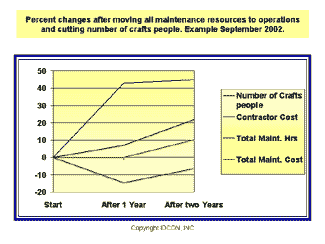I often get calls from organizations that are contemplating moving maintenance resources to area operations managers. They ask “Can operations manage maintenance?” I always ask why they would do that, what are the perceived benefits?
The answers include following justifications:
- Maintenance personnel will develop more ownership to the operations area.
- We will achieve a closer working relationship with operations
- We will need fewer managers and save money that way.
The justifications mentioned above are the most common reasons I’ve heard. I like to offer my opinions and experiences from many organizations I worked with that have made an effort to save money this way.
When Can Operations Manage Maintenance?
First of all: If your basic maintenance practices (Planning & Scheduling, Preventive Maintenance, Stores, Technical Data Base) are not instituted as a way of life, do not make the move to maintenance moving under area operations!
Why? It will lead to having many poorly performing maintenance organizations instead of having one poorly performing maintenance organization.
On top of that you will expect several, often inexperienced, maintenance managers to implement and/or improve on these maintenance basics.
Because of lack of knowledge in maintenance management, time, interest, willingness or all of the just mentioned the following things are very likely to happen within six to nine months:
- More maintenance people on shift. Because it feels more secure that way. As one consequence of more maintenance people on shift, operators will request a lot of “Honey Do” jobs.
- More maintenance people will be stationed in areas to be available and ready to react to problems. Because this leads to faster repairs of problems.
- Work requests will not be entered into computer system, because it is easier and more convenient to just call people.
- It will become more difficult to move people between departments for shut downs.
- Overtime and contractor hours will start increasing even though there are more people on shift.
- Backlog will start to go up.
- Equipment reliability starts declining. At this point the total maintenance cost has gone up, but operations managers might not see the whole picture.
There are additional typical phenomena to be observed and sometimes actions to improve the situation do not happen. This is often because the manager(s) who initiated the change refuse to see, or admit, that it was a mistake to do this.
Often it takes up to three years, or an earlier change of management, before someone with enough clout in the organization realizes that maintenance is out of control and we need to get back to a more central, but area oriented, maintenance organization so you can re institute the practices you used to have.
Fact is that many organizations can repeat the above mentioned cycle many times over a ten to fifteen years period. Well, it keeps consultants like me in business!
As you can see I am not in favor of handing over maintenance to operations. This is because I have seen too many situations as described above and no example on a sustainable improvement from handing over maintenance to operations.
It is also so, that if you have instituted the basic maintenance practices in a central/area organization, with a strong partnership with operations, there is no reason at all to change the organization.
The graph below shows a three-year case study on an organization that moved maintenance to be managed by operations in an effort to reduce the cost of maintenance.

Number of crafts people were reduced by 14.3% first year. After one year 6% was hired back. In the same time period contractor spending went up 88%.
Total maintenance hours including overtime, contractor hours and in house hours went up 10.5% and of course total maintenance costs went up a total of 29.2%. On top of that, reliability and production through put decreased 6%.
This mill is now investing in hiring and training more maintenance people, implementing lost maintenance practices and moving all maintenance resources back to professional maintenance management.





